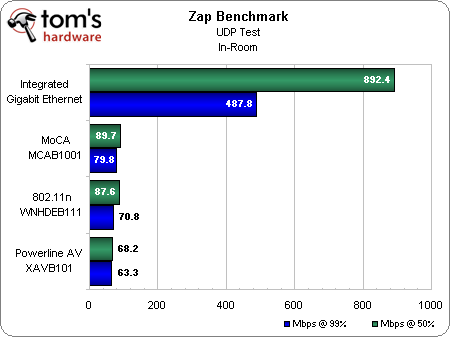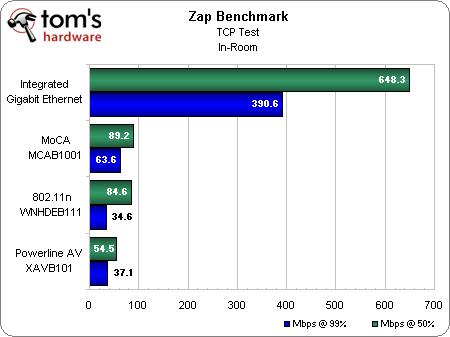Which Networking Technology Is Right For Your Home?
Benchmark Results: Zap Tests, Same Room
First, let’s check out our short-range test. Again, this is something of a best-case scenario. Obviously, no one is going to run a MoCA, WiFi, or powerline network solely in the same room. You’d simply run Ethernet and be done. Still, we can use these numbers as a benchmark by which to judge results taken from a more sensible in-home distance.
Predictably, Gigabit Ethernet using UDP blows everything else off the map. We expected to hit average (50%) numbers in the 800 to 900 Mb/s range and weren’t disappointed with our 892 Mb/s average. This is about as much as a 1,000 Mb/s Gigabit line can sustain. The interesting thing to note here is the 488 Mb/s minimum performance number. Taken in ratio against the average number, we see a much higher drop-off with Gigabit Ethernet than the other technologies, but let’s keep things in perspective. Only Gigabit Ethernet can let you run 10 or more concurrent HD streams at perfect frame rates with no visible glitching. Every other option merely competes for the most compelling runner-up spot. Because of this massive disparity between Gigabit Ethernet and everything else, we nearly eliminated it from our test set, but we felt the comparison had its own educational merits.
This same-room UDP chart sets the stage for most of our subsequent results: MoCA edges out WiFi, which in turn skates past powerline. Keep in mind that our Netgear MoCA and powerline adapters use 100 Mb/s rather than Gigabit Ethernet ports. We really wonder if MoCA might have distanced itself further ahead of WiFi and coax had Netgear implemented GbE. If and when MoCA 2.0 arrives, perhaps we’ll find out.
The TCP numbers may rank the same as the UDP set, but notice the differences. MoCA and the 5 GHz kit pull in similar average numbers, but we see a surprisingly large difference in the 99% results, perhaps indicating that all of that extra coax shielding may be helping packets get safely from point A to B unhindered, after all. Also noteworthy is that the Powerline AV kit manages to squeeze past the 5 GHz product on our 99% TCP test. The interesting take-away for us in these short-distance tests was not that MoCA blew past its rivals—which is sort of irrelevant since hardly anyone has multiple coax drops in the same room—but that powerline held its own against 5 GHz wireless. Yes, WiFi emerges as slightly faster at both average and minimum performance levels, but it wouldn’t take a lot of additional 5 GHz interference or a change in building materials to tip the balance strongly in powerline’s favor in a close-range networking scenario.
Get Tom's Hardware's best news and in-depth reviews, straight to your inbox.
Current page: Benchmark Results: Zap Tests, Same Room
Prev Page How We Tested Next Page Benchmark Results: Zap Tests, Across House-
rebturtle I'll be bookmarking this article for customers who tell me, "No, I don't want a wired LAN, I picked up this wireless router at WalMart....."Reply -
neiroatopelcc I like the netgear floorplan "Stairs to go upstairs" ... great!Reply
And nice article btw. Imo I'd have put the first rant about netgear after the section detailing that you're using it, so it looks more like an explanation than an advertisement (page 1) though. -
anamaniac Thank you for the article.Reply
I decided to skip getting a switch (as I still want interent on all connected devices anyways), and grabbed a 2.4/5GHz 820.11n gigabit router...
Has done well for me, just too bad my PSP can't use wireless N.
I've been tempted (and almost did) put new holes in my walls to drag my cat6 cables around my house (I only grabbed cat6 over cat5e because of the colour of the cables at my shop, however I do somewhat regret it because cat5e is a lot more flexible). -
neiroatopelcc Q: can regular people like I download the zap benchmark software somewhere? I'm the guy being blamed if our corporate network in two towns breaks down, and lately I've been hammered for unstable wireless network and can't find any cause for this. Would like to see minimum performance for our access points (got about 40 meru aps with dual radio and a,b,g and n concurrently).Reply -
Spanky Deluxe Gigabit ethernet throughout the house running through a gigabit switch in the garage here with 802.11g for the laptops until I get round to replacing the router we got with our broadband supplier with an Airport Extreme.Reply
Luckily the previous owner of the house was a network engineer and had left all the wiring throughout the house. I just hooked up a cheap second hand gigabit switch off eBay and have been loving it ever since. -
NicNash If you connect a power-line connector from a computer that is also connected to a wireless n network, to that router... will it use both adapters at same time? or whichever to provide best speed?Reply
weird thought.. but yea -
NicNash btw great article on these lesser known technologies. this article is worth its weight in gold to those who careReply -
neiroatopelcc nicnashIf you connect a power-line connector from a computer that is also connected to a wireless n network, to that router... will it use both adapters at same time? or whichever to provide best speed? weird thought.. but yeaDepending on the OS, but if you're running a standard microsoft os, it'll use whichever it detects a gateway on first. Has nothing to do with which is fastest or most reliable.Reply
Type route print in cmd if you want to see what it uses

